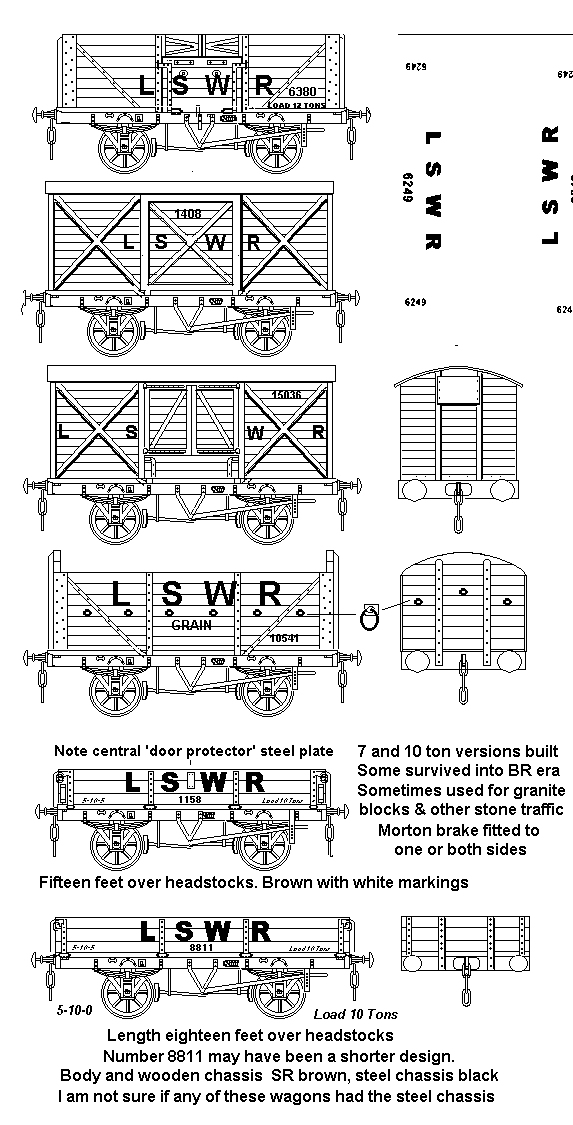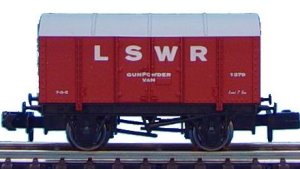
London and South Western Railway
(Note: Numbers in brackets refer to specific references)
The LSWR grew mainly from the railways promoted by shipping interests in Southampton. Southampton has four tides a day and does not require the enclosed docks seen at other major ports. The original name was the London & Southampton Railway, changed to LSWR in 1840. The company crest features the towns of London (Waterloo Station), Winchester, Southampton, Salisbury and Plymouth but they also served Bournemouth, Portsmouth, Dorchester and Padstow and owned a line extending through Exeter to the west. They also had running powers over GWR lines to Weymouth and over SECR metals to Reading and owned outright the isolated Bodmin & Wadebridge Railway in Cornwall. The barracks at Aldershot and the training areas on Sailsbury Plain were served by this company, generating a great deal of military traffic. In 1875 the LSWR and Midland Railway became joint owners of the Somerset & Dorset line, much to the annoyance of the GWR. The LSWR served the busy port of Southampton (they bought them in 1892) and operated steamers to France, the Channel Islands and along the British coast. One curiosity was the pioneering use of multi-modal transport for chilled meat landed at Southampton. The meat was loaded into horse drawn road vans and taken to the railway where the van wheels were removed and the van bodies were loaded onto railway flat wagons to be sent to London. On reaching their destination the van bodies were craned off and their road wheels re-fitted. This enabled the Smithfield market to receive chilled meat about eight hours after it left the stores in Southampton. The main London goods depot for handling the traffic to and from Southampton was at Nine Elms. The LSWR installed the first British automatic signals controlled by track circuit on the line between Woking and Basingstoke, these were fully operational by 1907. In 1915 the first of the LSWR electrified lines began operations, using the third rail system which was to become dominant in the subsequent Southern Railway.
Goods stock was painted dark reddish brown, basically the same as the subsequent SR brown, white lettering L S W R on the sides about 12 inches high and with a four or five figure wagon number in the lower right of the body about 6 inches high, underneath the wagon number was quoted the load in italic script e.g.: Load 10 Tons. On vans the number often appeared on the centre of the door, about two planks down from the top. Refrigerator vans were painted 'salmon pink' with dark red lettering.
Passenger stock was painted a dark brown with a pink/orange colour called 'salmon pink' upper panels. Non passenger coaching stock was all-over brown (including the chassis). After 1915 some of the new electric stock was painted all-over green, I believe this was applied to passenger coaches in general from about 1921. This green colour scheme was adopted by the Southern Railway after the 1923 grouping.
Fig ___ LSWR

The seven plank open wagon is a Peco wagon kit with additional strapping for the upper side doors added from 10x20 thou microstrip.
The sliding door van was fully described in Article XX (xx xx RM), the model shown here is the alternative hinged door version.
The longer three plank open wagon is a cut down Peco body mounted on a standard Peco ten foot wheelbase chassis, it was only after making the model I found out it should be 2mm longer.
The short three plank wagon is another Peco wagon body section, shortened and mounted on a cut down Peco chassis.
Dapol have released a model of an LSWR gunpowder van, they release their models in short runs to allow the production of a range of liveries, so you may need to wait a while for this livery to re-appear.

References:
An Illustrated History of Southern Wagons Vol 1 (LSWR and S&DJR) by G. Bixley A. Blackburn, R. Chorley, M. King, J. Newton - OPC - 1984 - ISBN 0 86093 207 9 Comprehensive coverage of the goods rolling stock with plenty of photographs.
Societies:
West Country Railway Archives
A site covering all the lines in the South West of the country with some interesting information on each of the companies covered.
Available Models
Bill Bedford Models, Leebiton, Sandwick, Shetland, ZE2 9HP
Mr. Bedford offers etched kits of the LSWR/SR D.1409 ten ton van, ten ton brake van and eighteen ton brake van.
Graham Hughes Kits 20, MacKelvie Road, Lamlash, Isle of Arran Strathclyde KA27 8NP
Mr. Hughes offers white metal kits of the LSWR five plank open, ten ton box van, ten ton cattle van and twenty or twenty four ton brake van.
Acknowledgements